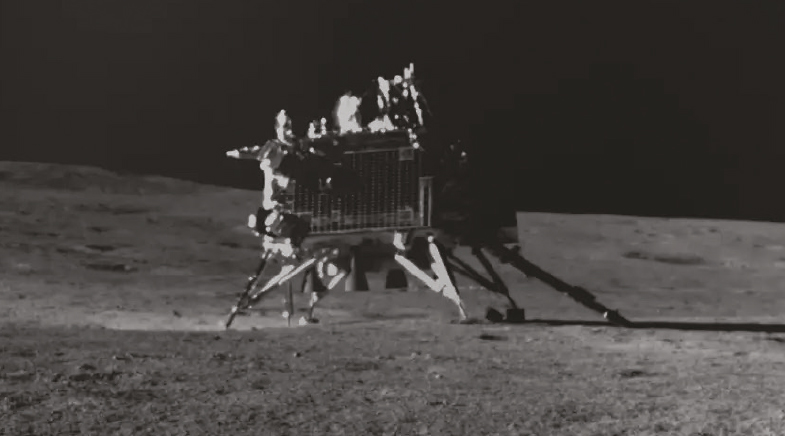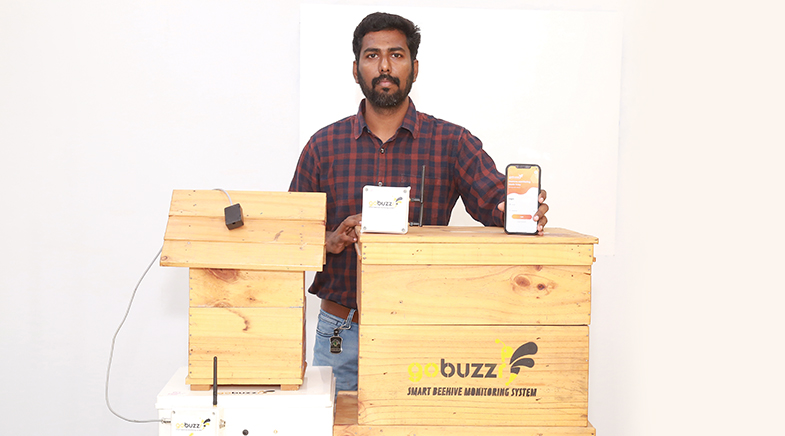Bolt from the blue
-
- from Shaastra :: vol 04 issue 08 :: Sep 2025

The old idiom that lightning does not strike a place twice may be ripe for a rethink. Scientists hold that some areas are more prone to lightning strikes than others. And meteorologists indicate that it may soon even be possible to predict a strike.
Lightning kills about 3,000 people in India every year. Those hit are not spread out randomly across the country. These occur in hotspots, and the time of occurrence is not accidental. Strikes may even have a preferred time of occurrence — that is, a diurnal preference. These insights and more are emerging from a growing database of lightning information being built up by the Indian Institute of Tropical Meteorology (IITM), Pune. Much of the data comes from the Indian Lightning Location Network (ILLN), launched by the Thunderstorm Dynamics group at the IITM. An assessment was published in Science Direct in July 2025 (bit.ly/ILLN-Paper).
According to the National Crime Records Bureau, lightning strikes are the cause of the highest number of accidental deaths involving forces of nature. On April 9, Bihar witnessed 13 deaths due to lightning in different parts of the State: five in Begusarai district, four in Darbhanga, three in Madhubani and one in Samastipur. Each of these strikes was independent, and the clustering hints at a pattern.
The ILLN was launched in Maharashtra in October 2014. Today, it consists of 112 detectors spread across India — from Ladakh to the Andamans to Mizoram. It is likely to expand to Lakshadweep. These networks detect the location, time of strike, peak current associated with the lightning and polarity of the lightning (whether it contains positive or negative charges). From the measurement of the speed of wind and clouds and their direction of movement, predictions can be made about which areas are likely to be hit by a thunderstorm and when.
The measurement of wind speed and cloud direction can help predict which areas are likely to be hit by a thunderstorm and when.
Based on the speed of the clouds, the scientists can estimate where a storm is heading and give about half an hour's warning about it. "By knowing or observing the perturbation produced by the lightning at four locations (four or more sensors), we can locate the lightning," says V. Gopalakrishnan of IITM, an expert on atmospheric electricity.
Until 2015, the readings were limited to observations from National Aeronautics and Space Administration (NASA) satellites. These inputs were meagre. "The satellites used were polar-orbiting satellites, and they made a [measurement] twice a day for some minutes," Gopalakrishnan says. The Lightning Imaging Sensor (LIS) instrument on the NASA satellite was widely used, but the mission ended in 2015, and the instrument was passed to the International Space Station. India has been receiving continuous lightning measurements after the Indian Space Research Organisation launched the geostationary satellites INSAT CDR and INSAT CDS.
To improve the quality of the measurements, the Ministry of Earth Sciences decided to set up a ground-based lightning monitoring system in 2017. The IITM collaborated with the Vaisala network, which operates and manages global networks to monitor the weather and the environment, and the Earth Networks, which provides hyperlocal weather intelligence and real-time lightning detection. The system required suitable points for installation and internet connectivity for data transfer — which were not always easily accessible. Sensors are also expensive: each of them costs about $40,000. "So finding a secure place is a problem," Gopalakrishnan says.
IITM's lightning sensor network was the first to be established in India. There are now several agencies that give information on lightning. Among them is a lightning detection network set up by Tripura University, under the leadership of Anirban Guha, head of the Physics Department at the Central university. This is the first indigenously developed lightning detection network. Called the Indian Lightning Detection Network, it primarily conducts research. The data collected is free for non-commercial purposes. Established in 2018, the network was fully operational in 2020, but began providing data in 2022, after the COVID-19 pandemic. It has ten sensors at present, one of which is installed in an India Meteorological Department (IMD) observatory in Jodhpur. The network plans to install detectors at all sites with IMD observatories. The funding model and proposal are under review. The Tripura University group seeks to optimise sensor positions rather than randomly deploying them.
NEED FOR MODELS
"Observations are important, but predictions require models," says Someshwar Das, Secretary of the South Asian Meteorological Association, a non-profit society of meteorologists from the region. It is a challenge to model phenomena such as thunderstorms and lightning, which are localised and short-lived. Das believes that to build a good model, it is necessary to develop the climatology of, say, 30 years. This would include databases of information on how much the lightning flashes vary at every location, the lightning potential index, diurnal variation, hotspots, and so on.
A slight change in the Earth's surface temperature manifests as a significant change in lightning activity, serving as a proxy for measuring climate change.
According to Guha, there are several variables other than temperature which mark climate change, and lightning is nonlinearly related to the health of the planet. "For every degree Celsius rise in surface temperature of the Earth, there is a 7-8% increase in lightning activity," he says. A slight change in surface temperature manifests as a significant change in lightning activity. This activity serves as a proxy for measuring climate change.
ALERTS WITH AN APP
In 2018, Shailesh Nayak, the then Secretary of the Ministry of Earth Sciences, suggested that lightning strike data be used in an app to give information about approaching thunderstorms. The proposal led to the launch of the mobile app, DAMINI. "Because the network is continuously monitoring [lightning strikes], we know in which direction the cell [the thundercloud] is moving," says Gopalakrishnan. By assessing the movement of the thunderclouds, the app informs users of a likely thunderstorm. This app is available in all recognised Indian languages and can be freely downloaded. It gives a red warning if lightning is extremely likely to occur, orange if it is likely to, and green if all is clear. The app can provide an alert within a 20-km radius about 30 minutes in advance of a strike.
In the years since the lightning sensor network was set up, researchers have gained deep insight into the subject. When observations were still being made using satellite data, it was believed that the Northeast had the highest incidence of lightning. It is now clear that the hotspots are in the eastern region — West Bengal, Odisha and Jharkhand. The observations also indicate a diurnal shift. For example, in the North, lightning mostly occurs after midnight, in the early hours of the day; in Odisha and Bihar, it is mostly between noon and 4 pm.

The most startling discovery is the increase in the occurrence of positive polarity lightning, or positive lightning (bit.ly/Positive-Polarity). Lightning is the leakage of charges from the cloud when the air breaks down and offers a pathway for this current to flow down to the ground. The cloud in question is usually positively charged on top and negatively charged at the bottom. When the pathway is established, some of the negative charges leak through the path and hit the ground. This passage of current is the lightning. Usually, since it is the negative charges that leak down, the lightning is also of negative charges, and it is known as negative lightning.
Positive lightning, or leakage of positive charges, can occur if there is a pocket of positive charge and a leakage pathway in a normal cloud. Another possibility is when positive charges in the top layer develop a downward, vertical movement and then slide down as a leakage, causing positive lightning. In another scenario, the cloud itself can have a reversed polarity, with negative charges on top.
Positive lightning is potentially more dangerous as it has a higher peak current and charge transfer than negative lightning. The IITM researchers believe the increase in aerosol pollution may have played a critical role in the formation of reversed polarity thunderclouds.
The project now plans to develop a portable device that would ensure protection from lightning, especially for those working in agricultural fields. "We are thinking of a technology for mobile lightning protection which will also be of low cost," says Gopalakrishnan. People can take these devices with them to work and install them on the ground. These will function as mini lightning arrestors. Research in this direction is ongoing.
Also read
Have a
story idea?
Tell us.
Do you have a recent research paper or an idea for a science/technology-themed article that you'd like to tell us about?
GET IN TOUCH














